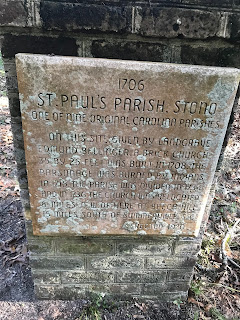South of Charleston off Highway 162 near Hollywood, the precious property, nearly 900 acres, is a gem. This avenue of live oaks harkens to the Old South, as does the large white brick entrance and fence. The place goes back to early Charleston area history. Later, in the 1930s it was owned by an Italian boxer. There are also wealthy Astor family and Titanic ship connections. Read more about this rich history in a College of Charleston written piece.
The “preserve” became the College of Charleston’s in the 1990s when owner John Henry Dick died. He had left his beloved plantation to CofC in his will.
The gravesite of John Henry Dick, a prominent naturalist and talented artist in the mold of John J. Audubon, can be viewed along one of the walking trails CofC has installed. He is buried within a site that also features an historical marker that says how these grounds once held one of the first Carolina colony Episcopal churches, St. Paul’s Parish, Stono. Click on the photos to more easily read them.
The church had its own graveyard. Today just one headstone remains, located not far from John Henry Dick’s. It goes way back to 1750 and is very remarkable for its good condition and the local and state history it represents.

Buried here is Amarinthia Elliott Lowndes. She was in her 20s (her age at death is on the marker but I can only make out the first "2") when she died during childbirth, according to a South Carolina Encyclopedia piece on her husband. The inscription says she was the “affectionate and much beloved wife of Rawlins Lowndes of Charles Town.” They had been married less than 18 months when Amarinthia died. The inscription also notes that she is buried near her parents here in what used to be a graveyard next to St. Paul's Church.
He was a lawyer who would become a governor of South Carolina and intendant (mayor) of Charleston. Rawlins was born on St. Kitts, an island in the Caribbean. My family and I have been to St. Kitts. I blogged about this amazing trip in 2011.
When he died in 1800, Rawlins was buried in Charleston's St. Philip's Church graveyard. A detailed biography of him can be read on this South Carolina Encyclopedia site.
The Lowndes headstone is an amazing piece of graveyard art and iconography. There is a cherub face with almost rosy cheeks. A cherub can be said to symbolize the soul of the deceased. Four trumpets surround the face with two looking like they are coming out of the cherub's head. Trumpets symbolize victory and resurrection, according to a symbols guide from cemeteryclub.com.
At the Stono Preserve, there’s also a small pet cemetery. I believe these were two dogs belonging to J.H. Dick. Winnie was a well-traveled pet, it seems.

Stono Preserve is today a tribute to Dick’s careful caretaking of his home.
Where rice and cotton were once grown, Dick transformed into grounds and waters attractive to birds, deer, and other animals. The College of Charleston has carefully honored and cultivated Dick’s vision.
I have a bit of history with this wonderful riverside place. In the summer of 2012 I came here about a dozen times. I made it a mission to see how many types of birds I could photograph. The bird count was nearly 40. I produced this large print showing all of them. The CofC president’s office ordered two prints, after I told someone there about my project. I don’t know if the school ever put them up anywhere. But I have framed prints in my home and office at SC State University.
This bird project came a year after my book “The Birds of Magnolia Cemetery: Charleston’s Secret Bird Sanctuary” was self-published. Dixie Plantation/Stono Preserve was where I had several “lifer” bird encounters. The colorful Painted Bunting was my favorite first-time seeing and photographing “lifer” here!
A bird not part of the above collection is one I was excited to see and photograph during my recent visit. This is an American Kestrel, which is in the Falcon family.
The photo above is the best picture I was able to get at such long range.
This was my first sighting, a bird on a pole. It was looking over a pasture for a meal, perhaps.
I did not know this was a Kestrel until I got home and was able to see the photos on a larger screen. I've photographed this bird before in other Lowcountry places. My first encounter was actually on the Caribbean island of Aruba. I remember thinking I had to go all this way to see an American Kestrel.

This is the Kestrel I shot (with my camera) on Aruba in 2013. See my "Birds of Aruba" post here.
The price of tracking this Kestrel- sharp little stickies all over my shoes and socks. Picking off one drew blood from my finger.
Here are some other birds I photographed on this day.
Great Blue Heron
Great Egret
Carolina Wren, the state bird of South Carolina with a bite to eat
Osprey
A butterfly pair. These are Common Buckeyes.
School of Spot-tail Bass in a creek that connects to the Stono River
This was a first for me- photographing fish in the wild like this! From the land into the water, I mean.
The dock used to be a nice walk to the Stono River. But it's in poor condition these days. I hope CofC fixes it.
Alesia and I had a good time strolling the grounds on a mild fall day. It was nice to reconnect with this interesting nature preserve.



























2 comments:
thank you so much for your post, im in love with this place. I even got engaged there and painted many times...thanks again for the details...
Olessia Maximenko
Thank you so much for your nice comments! It is a very special place. I'd love to see some of your paintings made there!
Post a Comment